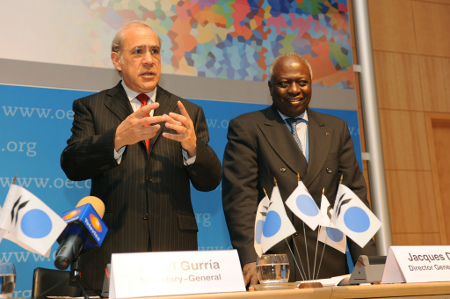In a series of commentaries looking at the implications of complexity theory for development, Owen Barder and Ben Ramalingam look at the implications of complexity for the trend towards results-based management in development cooperation. They argue that is a common mistake to see a contradiction between recognizing complexity and focusing on results: on the contrary, complexity provides a powerful reason for pursuing the results agenda, but it has to be done in ways which reflect the context.
In the 2012 Kapuscinski lecture Owen argued that economic and political systems can best be thought of as complex adaptive systems, and that development should be understood as an emergent property of those systems. These interactive systems are made up of adaptive actors, whose actions are a self-organized search for fitness on a shifting landscape. Systems like this undergo change in dynamic, non-linear ways; characterized by explosive surprises and tipping points as well as periods of relative stability.
If development arises from the interactions of a dynamic and unpredictable system, you might draw the conclusion that it makes no sense to try to assess or measure the results of particular development interventions. That would be the wrong conclusion to reach. While the complexity of development implies a different way of thinking about evaluation, accountability and results, it also means that the ‘results agenda’ is more important than ever.
Embrace experimentation
There is a growing movement in development which rejects the common view that there is a simple, replicable prescription for development. Dani Rodrik talks of ‘one economics, many recipes’. David Booth talks of the move from best practice to best fit. Mirilee Grindle talks of ‘good enough governance’. Bill Easterly has talked of moving ‘from planners to searchers’. Owen Barder has called for us to design not a better world, but better feedback loops. Sue Unsworth talks of an upside down view of governance. Matt Andrews, Lant Pritchett and Michael Woolcock aim to synthesize all this into their proposal for Problem Driven Iterative Adaptation.
These ideas are indispensable in the search for solutions in complex adaptive systems. In his 2011 book Adapt, Tim Harford showed that adaptation is the way to deal with problems in unpredictable, complex systems. Adaptation works by making small changes, observing the results, and then adjusting. This is the exact opposite of the planning approach, widely used in development, which involves designing complicated programmes and then tracking milestones as they are implemented.
We know a lot about how adaptation works, especially from evolution theory. There are three essential characteristics of any successful mechanism for adaptation:
- Variation – any process of adaptation and evolution must include sources of innovation and diversity, and the system must be able to fail safely
- An appropriate fitness function which distinguishes good changes from bad on some implicit path to desirable outcomes
- Effective selection which causes good changes to succeed and reproduce, but which suppresses bad changes.
- focus on solving locally nominated and defined problems in performance (as opposed to transplanting pre-conceived and packaged best-practice solutions);
- create an ‘authorizing environment’ for decision-making that encourages ‘positive deviance‘ and experimentation, as opposed to designing projects and programs and then requiring agents to implement them;
- embed this experimentation in tight feedback loops that facilitate rapid experiential learning (as opposed to enduring long lag times in learning from evaluation);
- engage broad sets of agents to ensure that reforms are viable, legitimate, relevant and supportable.
Read the full article linked here.















































